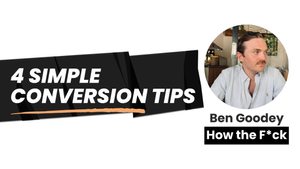You wrote an article that's not converting. Before you quit and move to the forest, try these 4 things.
You wrote an article.
It targets a BOFU keyword (i.e. "best software for X").
It talks all about your product and how useful it is.
But it's not converting.
Weird.
Frustrating.
Imposter-syndrome-inducing.
But hold your horses for a minute. Before you quit and move to the forest...
Here are 4 simple conversion techniques I think most content is missing 👇
1/ Use Simple Language
You could rank #1 for the best bottom-of-funnel keyword in the world and earn thousands in traffic, but none of it will convert if nobody reads the part where you describe and sell your product.
People don't read complicated.
So, if you do complicate things...people will skim over it and your messaging will get missed.
Especially if you're marketing to an audience that isn't totally familiar with your industry, jargon-y terms are just gonna confuse more than engage.
Here are some quick tips to make your product copy more simple:
- Use Bullet Points: Breaking down information into bullet points makes skimming easier.
- Be Specific: Instead of saying "we have lots of useful features that improve efficiency", say "features like 1-click upload of documents, AI that finishes sentences, and goals that propagate across teams all reduce the time spent on X".
- Use Images: I'm a big fan of simply screenshotting a landing page (with the product photo and copy) because typically it's very fast & effective at communicating a feature/benefit.
- Simplify Your Descriptions: Clearly stating what your product does in simple terms makes it easier to read and understand.
Content that converts is SUPER simple to understand. It's straightforward and communicates clearly.
2/ Make the right offer
A high-converting offer must be relevant to the reader's pain points.
If your offer doesn't resonate with their immediate needs (which your article should focus on anyway), your chances of conversion drop significantly.
Another common mistake I see is content tries to convert readers by sending them to a product/service landing page that doesn't align with the article they were just reading.
For example, imagine you've built a Parental Control App, where one of the features is website blocking.
To target audiences that might be interested in this feature, you write an article and rank #1 for "best website blocker."
If, within this article, you send traffic to your homepage (which focuses on your core use case, a parental control app) your conversion rate is sure to suffer.
Your readers were searching for a website-blocking solution, not necessarily all the features of parental control software. While your homepage likely mentions website blocking, it's probably only in passing and not enough to really grab the readers attention.
What would be better?
Create a landing page specifically for the website-blocking feature, then subtly introduce other features of your product. That way, you cater directly to their immediate interest, improving your chances of conversion.
To keep things simple, you can plan a landing page to go with each new topic cluster. That way all relevant traffic is funneled to relevant conversion pages.
Here are some final tips on making the "right" offer:
- Align your offer with funnel stages: A top-of-funnel article attracts readers early in their buying journey. Offering a product demo at this stage is unlikely to convert. Instead, provide intermediate offers like a template or ebook that nudges them deeper into the funnel. This approach aligns with their current stage and increases conversion chances. We call this "don't kiss on the first date."
- Offer a solution to a specific problem: If you're driving downloads, a high-converting offer addresses a single, specific problem your reader is likely to face. That makes it a compelling jumping-off point after reading your article.
When crafting your offer, always think about the reader of this article. Not your buyer persona in general.
The better your offer-intent match, the higher your conversions will be.
3/ Use discount codes
As content marketers, we often shy away from using discount codes, probably because they feel a bit cringe.
However, sadly, discount codes are still incredibly effective (I recently tested them with a client and saw noticeable improvements in conversion rates).
Here’s why they work:
- Reduce financial risk: A discount code lowers the cost barrier, making the purchase feel less risky.
- Trigger buyer psychology: Customers love feeling like they’re getting a bargain. A discount code can provide that feeling.
- Create urgency: Time-based deals (e.g., "Expires in 30 days!") encourage customers to act now rather than later, tapping into the urgency factor.
Here's how I fit discount codes into my BOFU template:
Title: 7 Best X Software
Content = Listicle:
- Introduction
- Best X Software Quick Summary
- Software #1: Client Name
- Product video
- Compelling product overview (targeted to reader pain points)
- Image CTA with discount code to "try now"
- Details on features (with lots of images)
- Software #2: Competitor Name
And, so on.
Simple, but it works.
4/ Include social proof
Social proof is a powerful, proven psychological phenomenon that's commonplace on product landing pages.
Yet, we seem to forget to use it within long-form blog posts...even when they are on product-focused topics.
Integrating testimonials, user reviews, and case studies within your blog content helps by:
- Building Trust: Seeing others endorse a product or service makes it seem more credible.
- Reducing Risk: Testimonials and reviews lessen the perceived risk of making a purchase.
- Creating Urgency: Popularity and positive feedback = FOMO!
Bit of a no-brainer to follow up product copy with a real quote from a G2 or app store that corroborates you. Try it in your next BOFU article 😉.
Those Four Simple Things Again
- Use simple language
- Make the right offer
- Use discount codes
- Include social proof
—Benny ✌️


